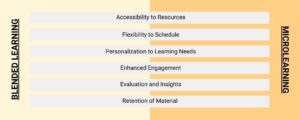Microlearning 101: Meaning, Benefits, and Best Practices

Modern deadline-driven workflow has rendered legacy training methods ineffective. It has shrunk the time employees have available for training, making it difficult to learn bulk information favored by conventional learning.
Today’s learners need relevant, specific, and digestible learning on the go to help them fill knowledge gaps and make them competent to fulfill their job responsibilities.
Enter Microlearning
Microlearning refers to the process of breaking down large learning content into easily-digestible, bite-sized chunks. These chunks are delivered effectively through multimedia like images, infographics, interactive PDFs, audio, short videos, and animations. Such content conveniently allows employees to upskill while performing their jobs.
Why Is It So Popular?
With the worldwide increase in smartphone penetration, internet connectivity, and access to cheaper data plans, especially in countries like China, India, Pakistan, Nigeria, and Indonesia, the global market for microlearning is expanding exponentially. It has garnered the attention of various industry verticals worldwide.
A recent CNBC study predicted that by 2025, over 73% of the global internet users (approx. 3.7 billion people) would access the web only via their smartphones. Consequently, in a few short years, the learners are bound to expect almost all of the online training to be mobile-ready.
It does not come as a surprise then that over 94% of e-learners prefer microlearning on the job, and over 95% of eLearning trainers choose it over conventional day-long seminars. Let us look at some of the benefits of microlearning and the best practices for its effective implementation.
Benefits of Microlearning
Microlearning is effective because people learn best when they focus on smaller pieces of content. It helps them avoid distractions and improves retention.
- Increase Knowledge Retention
According to research, microlearning improves focus and long-term knowledge retention by over 80%. When the content is bite-sized, the mind can easily process and retain it as compared to bulky and overwhelming information. The chances of redundancies are reduced because each microlearning course has a targeted focus on specific information.
The learners can target areas for improvement, acquire the required information, and quickly bridge knowledge gaps. They don’t need to sift through lengthy online training sessions to find the relevant sections.
- Highly Cost-Efficient
Conventional full-fledged online training courses need a lot of time and money to produce and distribute. A major expense is involved in creating lengthy content with multimedia, analysis, course design, staff (technicians, graphic designers, cameramen, editors, project managers, subject matter experts, etc.), development, and marketing.
Microlearning courses require only a fraction of that time and money. In his book 3-Minute eLearning, learning architect Ray Jimenez mentions that by implementing microlearning, online training providers can reduce development costs by over 50% while increasing development speed by over 300%.
This is because there is no need to rent physical venues and pay for classroom equipment, utilities, and instructors.It is less resource and time intensive to update digital courses than reprint training workbooks or manuals and conduct supplementary classes.
- Easily Accessible
With microlearning, employees can train on the go as they can access the content on their mobile devices whenever and wherever they need it. Since the content nuggets are short, they can be completed quickly. Employees can choose to squeeze in the learning during breaks or while commuting. This encourages them to complete the training and upskill.
- Trackable
It is hard to determine actionable business outcomes from conventional corporate learning. But in the case of microlearning, tracking the learner’s progress and gaining actionable insights is much easier.
With Microlearning platforms such as the CALF LMS, you can easily measure the business, social, and behavioral impacts of your learning offerings through its built-in Kirkpatrick model of learning measurement.
The detailed reports and smart analytics contain data on general as well as specific aspects of the training, including metrics like ROI, productivity, cost reduction, and other user-defined metrics.
- Support Personalized Training
Traditional training methods often contain vast information, and not all of it may be relevant to the employees’ roles. Microlearning courses can be specifically tailored to the learners’ needs, skill gaps, pain points, and expected outcomes. This allows for a customized and flexible learning path for the employees.
- Self-Paced Learning
With microlearning, rather than conforming to a structured and rigid learning course, the employees have the flexibility of learning at their own pace. It doesn’t matter whether they are getting that information for the first time or if they need to refresh their knowledge.
- Improve Morale and Engagement
Condensed microlearning courses facilitate quicker learning, faster progression, and immediate results. When the learners easily complete their training and constantly see progress being made, they feel more confident and motivated in their job roles. Quizzes, polls, simulations, flashcards, assessments, and surveys help enhance their engagement in the learning process.
This becomes even easier with Microlearning platforms like the CALF LMS that use AI to recommend and deliver just-in-time personalized content nuggets.
- Gamification
Gamification is a prominent benefit of Microlearning that adds an interactive and immersive angle to the learning process through role-playing and competitive elements. The learners can apply their training to real-world scenarios through simulations and better retain information. They can work towards measurable and meaningful targets in real time while making learning a fun, exciting, and engaging process.
Microlearning platforms like the CALF LMS support gamification through learning points, automatic certification, badges, leaderboard scores, and infographics. These help motivate learners, establish healthy competition among them, and increase their course completion rates.
The Best Practices
Microlearning is indeed the future of learning and development. Here are the best practices to follow for effective and successful implementation.
- Don’t churn out content that has little to no value for the learners or the organization. Know your audience and understand their current skill levels, existing knowledge gaps, employee profiles, learning requirements, and expected results. Only then will you be able to provide them with appropriate, relevant, effective, and useful content just when they need it.
- Cramming excess information into short videos, documents, or infographics defeats the very purpose of microlearning, overwhelms learners, and interferes with their daily workflow.Condense the subject matter to the very fundamentals, and cover only a single individual topic, subtopic, or skill in a multimedia bite that the learners need to complete the tasks at hand.
- Contextual information that serves as history or background learning for the necessary topics must be avoided or left for full-fledged macro courses instead of being stuffed into the micro nuggets. Learners need just-in-time solutions that keep cognitive overload at bay.
- It is important to schedule the content and deliver the information bites at regular intervals. Making all the information available at once can compromise retention and engagement.
- Make the content easily accessible on mobile devices to make online training convenient for learners and increase participation.
- Microlearning can’t be used for studying bulky subjects because the standalone multimedia chunks are too short to cover highly technical or elaborate concepts and can fragment learning. Instead of trying to impart complex information through microlearning, you can use it to supplement the in-depth macro learning courses with quick summary videos, flashcards, assessments, surveys, quizzes, etc., and help learners quickly revisit and strengthen their concepts.
- Sticking to one content delivery format can become repetitive and monotonous for learners. It is important to switch between different media (videos, audio narration, infographics, interactive PDFs, documents, images, simulations, animations, etc.) to cater to different learning preferences, diversify the deliveries, and keep the training engaging.
- Include experiential learning through real-world examples to make the content practical and relatable for learners and improve retention.
- Most importantly, it is essential to invest in a robust and customizable AI-powered Microlearning platform such as the CALF LMS to design, deliver, manage, and monetize your training offerings effectively. You can
- Customize learners’ journeys
- Personalize content recommendations through AI
- Make the online training mobile-ready through iOS, Android, and web support
- Effectively track specific business, social, and behavioral outcomes of the training
- Enable learners to learn just what they need, on the go!
To know more about microlearning and how CALF LMS can help you leverage its full potential, talk to our learning expert or schedule a demo.
Share This Post
Subscribe To Our Newsletter
Get updates and learn from the best
More To Explore

LMS for Professional Training and Coaching Needs
The users of Nuveda’s proprietary CALF™ LMS platform may be found in various industries and functional domains. One such domain is Professional Training and Coaching. These trainers and coaches use different online learning platforms to impart their programs to learners located across the world. What are some of these platforms? The choice of platform depends on factors such as the type of training or coaching being offered, the preferences of the trainer, coach, and clients, the desired features and functionality, and the budget available for investing in technology. (https://nuvedalearning.com/blog/post/10-key-aspects-to-look-in-a-learning-management-system-lms-2019/) Most professional trainers and coaches prefer platforms that offer all these above requirements in one place. Nuveda’s proprietary CALF™ online learning platform offers all of these in one location. (https://nuvedalearning.com/blog/post/how-to-leverage-microlearning-for-corporate-training/) In conclusion, the right online learning platform for professional trainers and coaches offers the right features needed across the coaching journey. CALF™ houses all of these modifiable and customizable features and has received much appreciation from our clients so far. Schedule your Learning platform Demo today!! (https://nuvedalearning.com/calfv4/)

Blended Learning and Microlearning
Blended learning is a method of imparting learning that combines in-person instruction with online learning activities. It integrates technology with traditional classroom methods to enhance the learning journey. The highlight of a blended learning approach is the ability for a learner to self-pace and hold control over their experience. This could involve online discussions, instructional videos, interactive modules, or virtual simulations, while still offering the opportunity to interact face-to-face with teachers and peers. With the flexibility and customization of blended learning, the learning process can accommodate diverse learning styles, provide opportunities for self-directed learning, and foster collaboration and critical thinking skills. The importance of blended learning includes: However, the success of such an educational approach depends on the thorough and strategic implementation. Here are a few best practices that educators can apply: Alongside blended learning exists another impactful approach to incorporate into your educational efforts. Microlearning is a method that involves delivering short, focused bursts of content to learners, as small modules or lessons. These units are designed to be short and digestible, catering to short attention spans of users. By incorporating brevity, engagement, and on-demand accessibility, retention of content is improved. (https://nuvedalearning.com/blog/post/microlearning-101/) Microlearning is commonly used in corporate training, employee onboarding, professional development, and skills enhancement programs. Its ability to deliver targeted training efficiently, particularly in industries where employees need to quickly acquire new skills, has gained much appreciation. A few of its wide-ranging benefits include: As technology continues to evolve, microlearning is likely to play an increasingly important role in education and training across various industries. Similar to blended learning, the success of microlearning depends on how effectively it is implemented. Here are some best practices for creating and delivering microlearning: In conclusion, a learning program that incorporates the essential ingredients of blending learning and microlearning approaches can see multifold benefits across the learning journey. Work with Nuveda Learning to enhance and enrich your coaching and training programs, through our proprietary MyNuclo LMS! Schedule your demo today. https://nuvedalearning.com/calfv4/

